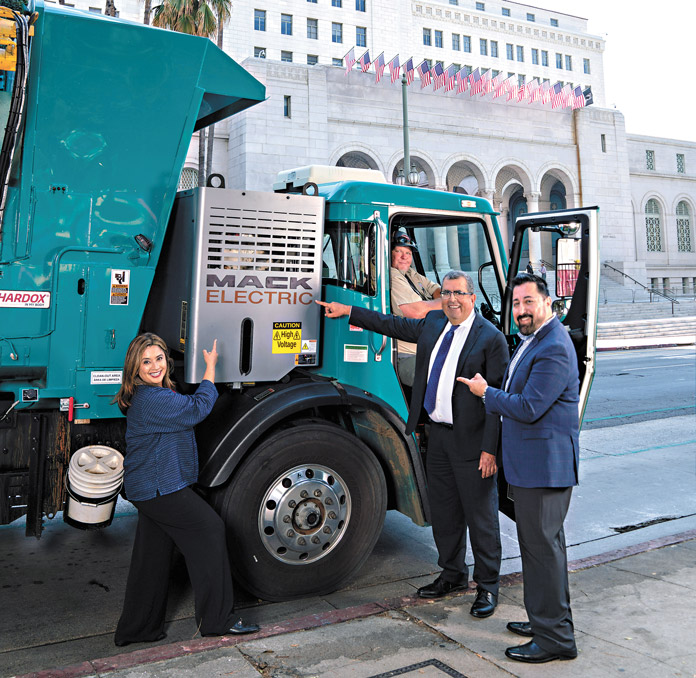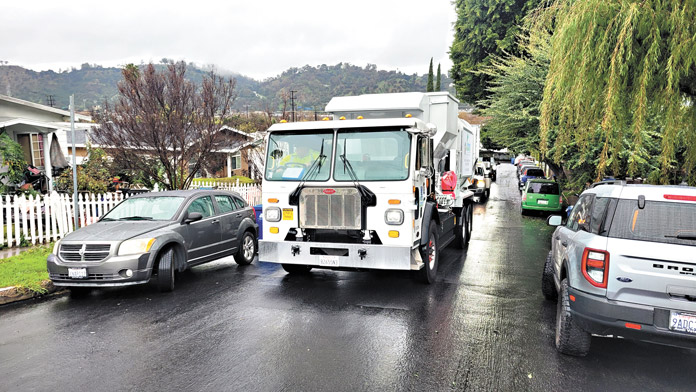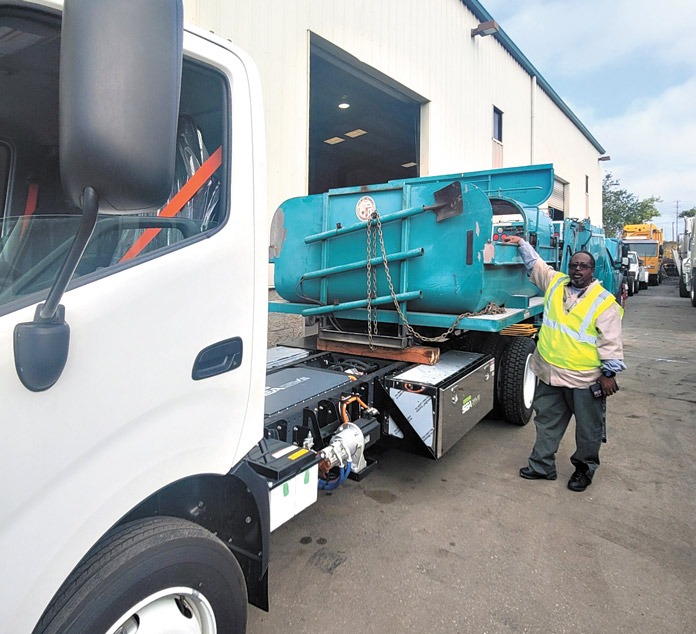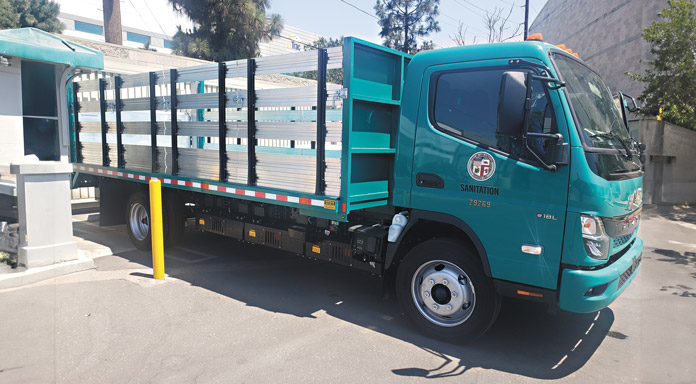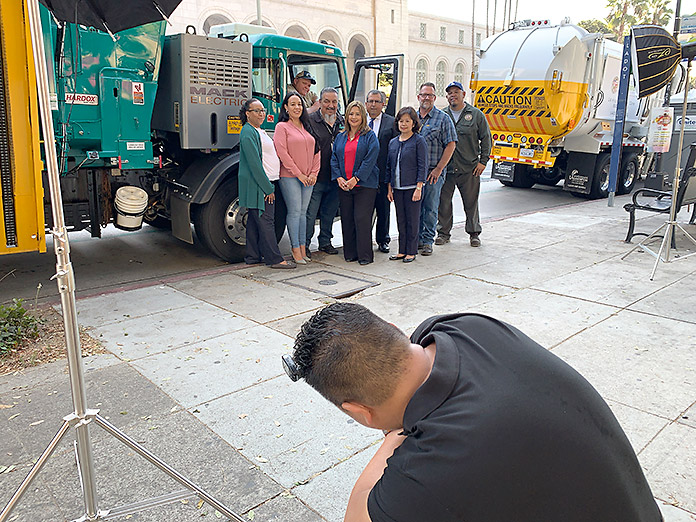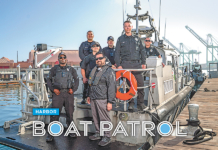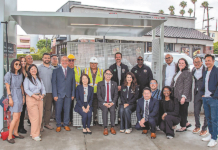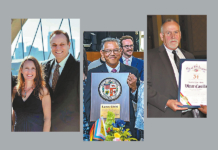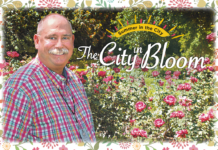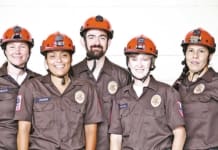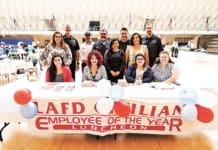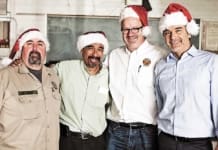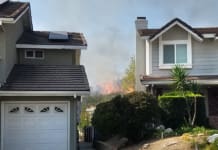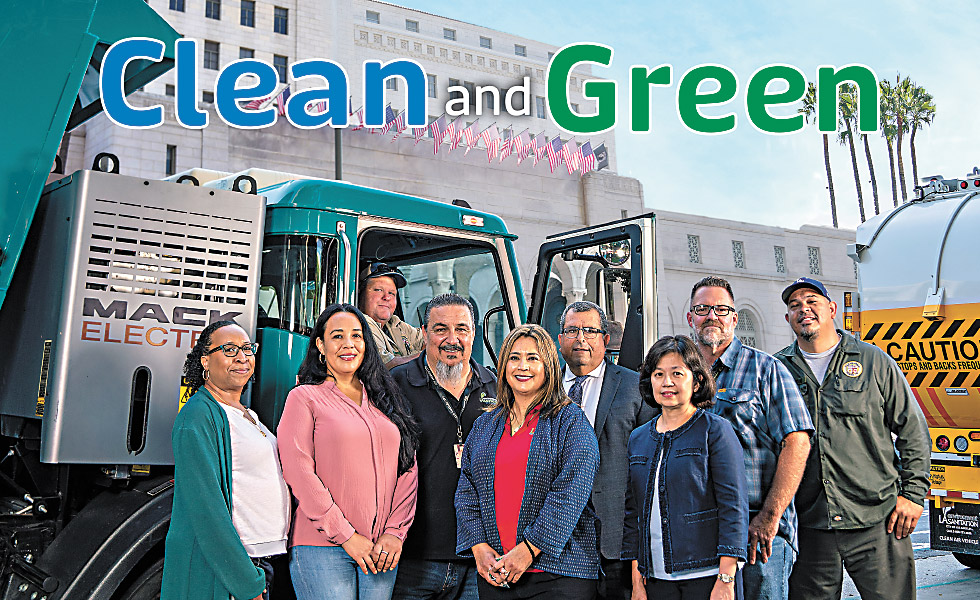
Alive! photo by Summy Lam. Photo illustration by JJLA Associates.
T
he refuse collection vehicle rumbling down your street soon will become more of a hum, as LA’s Sanitation and Environment Division of Public Works continues on the path to zero emissions.
The revolution will take time as the division works through the daunting challenges of battery technology, climate change, load factors, future-proofing and spending tax revenues wisely.
The revolution began in 2000 with the City Council adopting a clean-fuel policy. Sanitation launched its clean-fuel program with the deployment of 10 (and eventually 240) dual-fuel solid resource collection vehicles. These vehicles used Liquid Natural Gas (LNG) and diesel to power the vehicles. Its current clean fuel fleet is composed of mostly dedicated natural gas-powered vehicles. Its vehicles are powered by either compressed (CNG), liquefied (LNG) or Electricity.
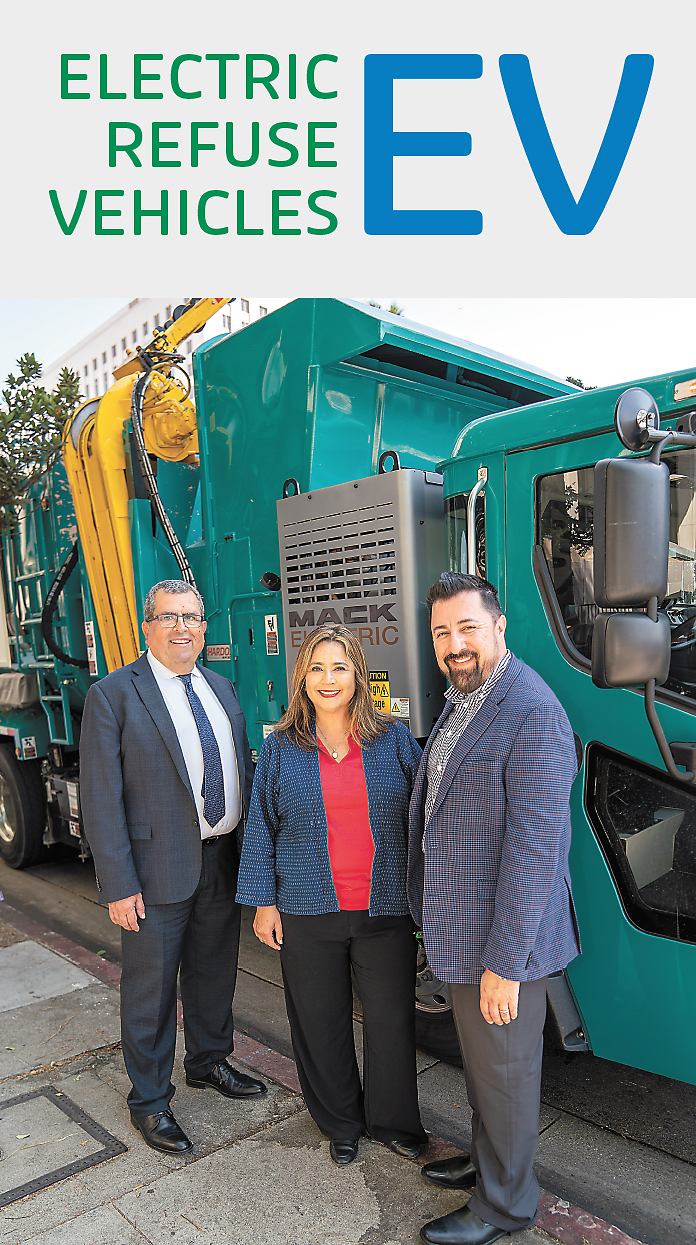
In 2017, Sanitation began testing electric solid waste vehicles. In 2018, Sanitation and General Services issued its first purchase requests for electric trucks (non-refuse vehicles at first). And now at the beginning of 2025, the division has active all-electric refuse collection vehicles on the streets of Los Angeles, collecting trash. The electric refuse collection vehicles are still in the testing phase, but the program is advancing toward purchase and full-time use.
Since 2001, more than 52 million gallons of diesel fuel were avoided, reducing emissions of more than 18 tons of particulate matter.
And they’re just getting started.
In this informative, honest and positive interview, Sanitation experts Charlotte Tan, Bill Musselman and Ron Cole detail Sanitation’s past lessons, current discoveries and future plans to make LA the cleanest big city in the United States. Enjoy!

On Sept. 5, 2024, Club CEO Robert Larios and editor John Burnes interviewed Sanitation’s Charlotte Tan, Environmental Supervisor II, 20 years of City service (at the time of this interview); Bill Musselman, Acting Superintendent for Support Services and Acting Fleet Manager, 25 years; and Ron Cole, Solid Resources Manager I, 35 years. The subject: Sanitation’s growing fleet of electric vehicles and the department’s plan for growing its green strategies.
Bill and Ron work under the Support Services division of the Solid Resources Group and are Club Members. After this interview was conducted, Charlotte transferred to the Solid Resources Commercial Franchise Division; her new title is Sanitation Solid Resources Manager I. She is also a Club Member.
Thanks for joining us today and talking to Club Members about Sanitation’s commitment to green initiatives. But first, tell us a little bit about your career path.
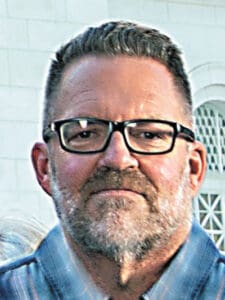
Bill Musselman: Mine started back in 1999 with the City of Los Angeles. I applied back in probably 1997 for a Gardner Caretaker position, but that didn’t pan out. I had a commercial license, so I thought a Trash Truck Driver sounded interesting. I was hired in November of 1999.
In 2001, I was selected to go to the LNG [liquid natural gas] pilot program, the precursor to what we have now, essentially. All the LNG and CNG [compressed natural gas] vehicles are eventually going to be replaced with electric trucks. Way back when, we were trying to clean up the air for the residents and now I’ve been working with Ron and Charlotte for the past nine and a half years, doing what we can do to bring electric equipment, trucks and all sorts of electrical gear to the City of Los Angeles.
Before I started working with Ron back in 2015, I was a Lead Man for 13 years in the Bulky section. I helped run the Bulky section for a few different Supervisors. I did bulky collections as well during that time. I then did a couple years driving the roll-off truck, picking up from LADWP facilities and other entities throughout the City. In 2015, I was appointed Supervisor in Support Services, that’s how I started working for Ron.
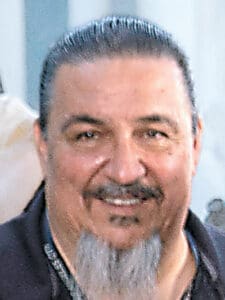
Ron Cole: Just like Bill, I started off in 1989 as a Driver. Back in the day when we were throwing cans, automation was a dream. When you’re throwing cans by hand, you dream about saying, “I’m going to have a machine that actually lifts the can and throws them in the hopper.”
By throwing cans, you mean taking the can by hand from the sidewalk and dumping the contents by hand into the vehicle.
Ron: Yes, manually. It was a one-man truck. There was no loader.
From there I went to Safety and Training for a short period, then to a Supervisor, then a Superintendent, the Fleet Manager. And then just recently in the last year, I was appointed to Solid Resources Manager I for four different sections – Container Services, LNG fueling, the Ambassador Program, and also the SOS group, Special Operations, because we get asked to do a lot of things that aren’t dealing with trash. It might be helping the yard get something taken care of just to help the employees there get something that we’ll help out in that sense. We’ll come up with temporary solutions to help employees from time to time.
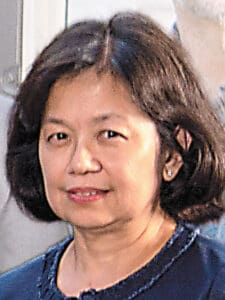
Charlotte Tan: I started as a Laboratory Technician at the Environmental Monitoring Division laboratory at the Terminal Island Treatment Plant. I’ve been in Sanitation for 20 years; I’ve never left. After two years I moved on to become an Environmental Engineering Associate at the Citywide Recycling Division. I was doing everything that involved the S.A.F.E. Centers for nine years; S.A.F.E. Centers [Solvents, Automotives, Flammables and Electronics] are permanent household hazardous waste collection facilities in the City. We have seven of them. I was involved in everything–from construction, design, planning, operations, maintenance, and regulatory compliance.
Then I moved to Support Services as an Environmental Supervisor. I’ve been working on EV projects since I moved here in 2016. I’ve been working with Ron, Bill, others testing and talking to vendors about electrification, looking for the right vehicles for different situations. The work that I do is related to grants, incentives and funding. But right now we are busy with compliance with the new state regulation that took effect early in 2024. The state of California wants fleets around the state to be electrified by 2045. We opted for the ZEV Milestone path related to the Advanced Clean Fleet compliance.
| MACK ELECTRIC REFUSE VEHICLE
This Mack is Sanitation’s third fully electric refuse collection vehicle. This vehicle, a side loader, is on loan and being tested for its capabilities. From left: Director and General Manager Barbara Romero, Club Member; Assistant Director Alex Helou and Club CEO Robert Larios. In the cab: Refuse Collection Truck Operator Mark Jobb. 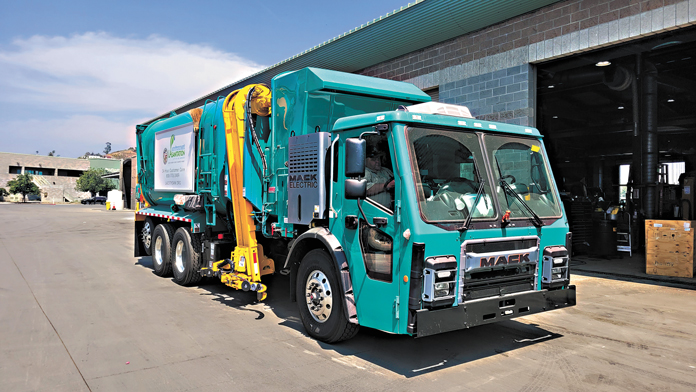 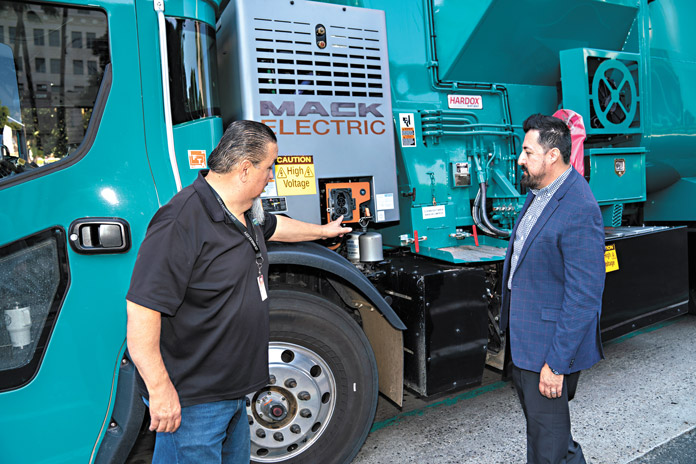
|
 Status Check for Sanitation EVs
Status Check for Sanitation EVs
Describe what your division or team is and what it’s all about. Is it EV testing, procurement, maintenance, or all those things?
Ron: Our commitment to the City is to provide alternative fuel vehicles, and electric is the current focus, even though we’ve been looking at it since 2015. Back in the day, Dr. Kim Tran was a big proponent of getting the alternative fuel system started. We purchased two CNG vehicles back in 1996, with type three tanks that could hold only maybe 40 or 45 gallons of fuel. It was very limited. That’s kind of the model now – with electric, we don’t want to buy or test a huge number of vehicles until it makes sense to do so. That way we are fiscally responsible. Plus we don’t have money to go out and buy whatever we want. To be smart, we have to strategize testing and evaluation of demonstration vehicles that each of the vendors has, and we try to get those demonstration vehicles for as long a period as possible. You might have a test vehicle for four days or five days and it might work fine, but after day six, you might start having issues. And then we also look at the customer service that we get from the vendors, and that’s a huge factor.
Bottom line, our task at LASAN is to get the trash off the ground so we can take care of the health and welfare of the residents of the City of Los Angeles. That’s our job. By providing trucks that burn clean air, that helps reduce the greenhouse gases that the trucks are putting out.
Right.
Ron: We try to do our job in a sensible way and not just put all of our eggs in one basket. We test as many vehicles as possible. Right now we have one vehicle given to us for one year at no cost to try out; it’s an electric automated side loader – side loaders are our bread and butter. Another company, through a grant, gave us two of their trucks for a year. We’ve had issues with our loaners, so at this point, we’re afraid to purchase a large amount of them. We’re not against purchasing small amounts, so we keep testing the newer technology, because things change almost daily.
Where we are now is that you can put only so much battery on a truck before you start losing the capacity to carry payload, and we need X amount of payload to do the job. We’re comparing the EVs with our diesel and natural gas trucks for performance. We’re shooting to get something available to us that delivers at least the bare minimum.
Bill: The weight of the batteries right now is so heavy, we’re not legally allowed to carry the same weight of trash that we can with an LNG or CNG truck, so we need more vehicles to do the same job – more vehicles means more drivers, mechanics and Supervisors. We hope in the very near future that batteries weigh less so we can carry more trash on the truck; that would be a more viable option for us to use in place of a traditional natural gas truck or diesel burning truck.
Ron: We also look at safety. We just purchased some EV stake bed trucks that needed modification to meet LA City regulations – the steps have to be 18 inches off the ground to protect our employees from getting in and out of the vehicle. Safety is the first priority, then it must perform to our requirements for the duty cycles that we ask it to meet.
That’s a long answer, but it’s our current status.
Right, thanks.
Charlotte: In the Support Services Division of the Solid Resources Group, our basic task is to support the operations at the collection yards and of the fleet. We do the testing for them, supporting their contracts. The Sanitation solid resources collection fleet is the largest fleet in Sanitation. We have to test; otherwise we may plunge into a catastrophe. (Solid waste) collection is the main service we provide the City, so efficient and effective equipment is critically important.
Ron: We’re the largest clean air municipal fleet using primarily natural gas fueled refuse collection vehicles. The other municipal fleet that would come close to us in size is New York, and New York has maybe 1 percent of its fleet as alternative fuel if you don’t count Bio Diesel. We’re in the high 80th percentile. If the pandemic hadn’t struck, we probably would be at 100 percent. This January, we’ll be 100 percent clean air vehicles. As far as our RCVs, our heavy-duty vehicles, it’ll all be either natural gas or electric.
That’s impressive.
| PETERBILT ELECTRIC REFUSE VEHICLE
Sanitation has also taken possession of two fully electric automated side loading refuse collection vehicles manufactured by Peterbilt. These vehicles, also in testing, were the first two electric side loaders being tested by Sanitation.
|
 Critical Input
Critical Input
How much are you dealing with the manufacturers to advance that sort of technology?
Bill: My staff drives the trucks every day. We work very closely – 100 percent –with the manufacturer to provide feedback on what is working and what’s not working. Sometimes vendors come out and make changes to the programming or upgrade the hardware to better suit our needs.
In the recent past, we had a rear loader truck we were testing for roughly a year. We were in contact, daily, with the engineers who built the truck, programmed it and worked on it. In some instances, they were coming out twice or three times a week to make updates to the regeneration mapping, to make sure the batteries are recapturing any power that can be recaptured while braking. We had transmission shifting issues and battery overheating. We’re definitely working hand in hand with the manufacturers to improve their product to make it more suited for us and better for everybody.
Ron: It’s really important who we choose to partner with for the vehicles that are going to go out on the street. It’s one thing to see them in a showroom or at an event, and another to put that vehicle out on an actual street and pick up trash with it. And like Bill said, we worked side by side with these people, brought them in to explain to them. We gave manufacturers certain specifications that we wanted to see, and for the most part, other than some of the tonnage, they’ve met them. We’ve issued POs and should start seeing deliveries of electric rear loaders before the end of 2024. We’ll have electric rear loaders running down the street that have City green paint on them that are owned and serviced by General Services. They will be some of our first electric heavy-duty vehicles out there.
Bill: We’re also going to be getting some DAC [dead animal collection] trucks and some stake bed trucks by the end of 2024 as well; fully functioning electric vehicles.
Charlotte: We’re doing a joint project right now with the AQMD [the South Coast Air Quality Management District]. It’s funded by AQMD, and we are the operator of the vehicles. It’s an important project because the data that we collect will be shared with AQMD and other stakeholders. This will help not only the City, but other jurisdictions as well.
Ron: Starting off back in 2015, some of our original numbers were from the science that was available at that time. We thought you could run an automated side loader, with about the same amount of energy as a street sweeper. We thought you could have a 250-kilowatt-hour battery, and you’d be able to go out there and collect a whole route. Well, now it’s being said that it will probably need closer to a 500-kilowatt battery. But that’s so heavy that you would lose more payload.
We’re rooting for the new battery science as soon as possible.
| HINO ELECTRIC REFUSE VEHICLE
Sanitation is also testing a Hino electric vehicle for the removal of dead animals. It’s being tested in collaboration with Animal Services.
|
 Electric Policy
Electric Policy
Talk about teamwork – teaming up with the Mayor’s Office to advance the green energies in Sanitation and Environment.
Charlotte: We are part of the EV Task Force, with monthly meetings. It’s headed by the Mayor’s Office. We have the same goals of electrifying our fleet. The City has a zero-emission first purchasing policy, whenever there is a vehicle that can work with Operations.
Ron: When we go through our purchasing cycle, if there’s anything out there that’s available in electric and it works for us, we’re now bound to purchase that vehicle first, as opposed to purchasing any other type of fuel for it. That’s a big effect because we have to look at our budget and ask for that extra cost because on trucks, it’s probably a 30 percent or 40 percent increase in price. In cars and trucks, they’re coming down a little bit more. We have to be careful when we budget; it’s not just the purchase price but the infrastructure cost, too. To put a charger in costs about $90,000 per port; each charger has two ports, so you can plug two vehicles into that one charger. That totals $180,000 installed. But that’s not including what it’s going to cost for the LADWP to bring that power to the yard.
Most of our yards are at their peak power. We already have 30 chargers planned to be installed, and I think we’re at 24 or 25 installed or commissioned. We have approximately 59 electric vehicles on order, so we’ve got to make sure we have enough chargers. We’ve always looked at the cost of things and tried try to do what’s best for the City. We don’t have an open checkbook. I have to tell our vendors that frequently.
Bill: That’s why it’s so important that we work with the vendors closely on what we need, and what works and doesn’t work for us because we are bound to buy it if it’s electric and available. We can’t put it off for another year. We need to buy it now if it’s a viable option. We have to tell our vendors exactly what we need it to do.
Ron: Several vehicles are available. Some vendors say their vehicles are ready to use, but they’re really not. They’re close, but we can’t go out day in and day out and collect trash with a vehicle that is “close.” We have to have something that’s up and beyond the ability to collect trash.
Understood. What do you have on order?
Ron: Our first and foremost goal is keeping up with the CARB ACT ruling that just came out, and that also affects the manufacturers. If we buy anything from any manufacturer, nine percent of their vehicles have to be electrified.
Charlotte: Right, but the core of it would really be the City compliance requirement I mentioned earlier. Sanitation has a schedule to keep to remain compliant, and that guides us.
Bill: Right now we’re looking at a two-year delay in getting the power to the yards that we need to charge all the trucks. If we have the trucks right now, we wouldn’t be able to charge them for at least two years, if even then.
Charlotte: We’ve been working closely with LADWP. They’ve already notified us that it would take at least two years for any power upgrades at our facilities. And that’s just the six solid resources collection yards, not including the Clean Streets yards and all the other Sanitation facilities that need to be electrified. Electrical upgrades are required for us to comply with Advanced Clean Fleet regulations and the City’s goal of zero emissions as well.
Ron: Our City goal is to be fully electrified by 2035, which is five years before the CARB ruling kicks in, when everything by 2040 will have to be electrified. There’ll be no more ICE [internal combustion engines] available by that year. Some changes will probably be even before that.
Ron: Even when we went to natural gas, we started off with small numbers, and that’s our same plan of attack now; we’ll start off with small numbers. As we feel more confident that they will do the duties that we’re asking them to do, then we’ll buy larger numbers to be able to get the numbers to where all 900 of our RCVs will be electrified. Electrifying our entire fleet is going to be challenging with the current technology. I hope there’s different technology. Hydrogen trucks are still considered a non-emissions or zero-emissions vehicle. CARB is still fighting back that it’s an ICE engine, and they don’t really like that. But it’s putting out zero emissions.
| RIZON FULLY ELECTRIC STAKE BED
Refuse collection vehicles are not the entirety of Sanitation’s fleet; it’s also expanding its fleet with fully electric stake bed trucks, including this model from Rizon. 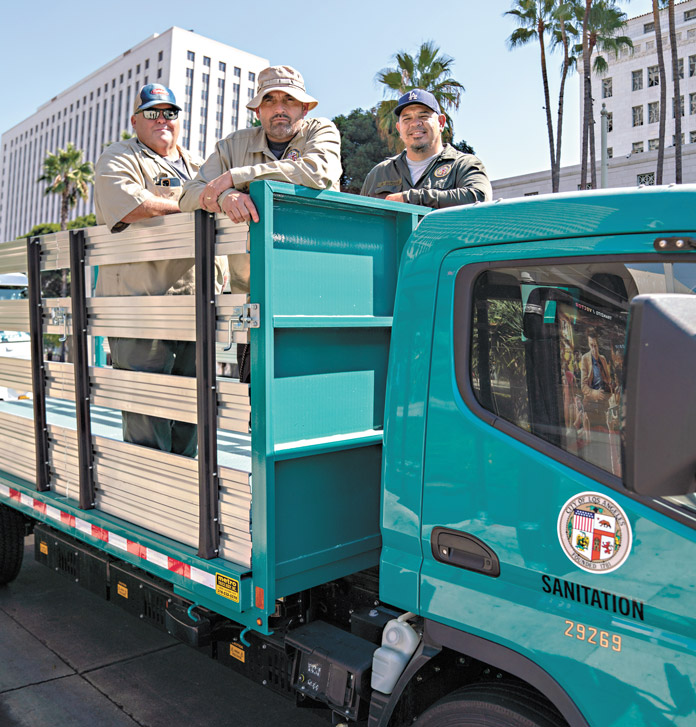
|
 Critical Importance
Critical Importance
Why is the EV collection vehicle program important to LASAN?
Ron: We’ve always felt ourselves as stewards of the environment. Going from a near-zero-emission vehicle to a true zero vehicle, we felt it was important to go that route for collecting trash. In wanting to protect the environment, it’s very important to us to be able to have that out there and provide our residents with the most advanced clean vehicle that’s available.
Bill: The public wants to have a clean-burning future, and they think that’s electric. We want not just the appearance of having electric vehicles to make it look like we’re doing something good, we’re trying to actually get the air cleaner and keep it clean for them; for our future generations.
Ron: I grew up in the San Gabriel Valley where we had smog alerts. The mountains were about five miles from my high school and you couldn’t see them most of the summertime. And now, other than days like today when it’s super-hot and under unusual circumstances, you can see the mountains. It might not be crispy clear as on a winter day, but you can still see the mountains. When I was a kid, you couldn’t see that. You couldn’t go out and play sports on certain days. That’s my personal view – you can see the difference now. We’ve made progress on this whole thing; it’s not just bells and whistles. You can look from that same corner where my high school was at and see the mountains now.
Charlotte: To keep up with Sanitation’s mission and vision of protecting health and environment, it’s important for us to use the best and the most effective equipment to minimize the impact of our operations. When the vehicles collect refuse, it’s important that residents are less likely to be impacted by our operations. People and jurisdictions around the country or the world look up to the City of LA as a leader, a model. It’s important for us to get this right because we serve as a model.
What other clean air initiatives is Sanitation working on?
Bill: We’re in the process of retiring all our diesel trucks. AQMD is giving us grant money to accomplish that.
Ron: Sanitation is definitely the leader in getting grant funding for our vehicles. We’ve gotten about $36 million in grant funding. Our Assistant Director, Alex Helou, plays a big role – to me, no other City department has done as much as ours has, as far as getting grant monies back, and also getting clean-air vehicles out there on the road. No other City department has done that. I guarantee 100 percent.
Charlotte: We are lucky that we are well supported by our executives. If we have some concerns, we bring it up, and they will listen. That’s the only way; it has to be a working team.
We started this move to retire our diesel fleet around early 2000 and replace it with natural gas, which is expensive. We are proactive in applying for any grant opportunities out there. We have a very good relationship with AQMD and CARB; that’s why every time grant opportunities become available, we ask for their support for our fleet, for our program. It’s not an easy job; there’s a lot that’s needed. There’s a lot of legwork that’s needed, a lot of data collection and things like that. But the good thing about that is we get about a 20 percent return for every vehicle that is qualified for grant funding. We have a current contract with AQMD that helps us out with the demonstration project; the initial EVs that we are procuring are actually grant funded. We value taxpayer money, and it’s important that we save as much as we can. We don’t want to waste any tax dollars out there.
Ron: Our Technical Services Division helps procure all the vehicles. Bringing in these extra grants takes more paperwork. They were kind of shocked at how many of these grants that we’re going after. That’s the first thing Charlotte’s group asks – “Is there any grant money tied to this vehicle?” For the second rollout of grants, we were both on the phone, ready to go, ready to push buttons and make sure we got accepted for 36 of the 59 electric vehicles we purchased.
BATTLE MOTORS FULLY ELECTRIC REAR LOADER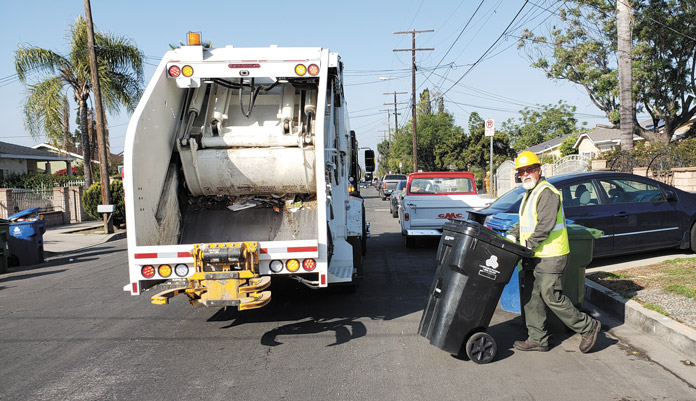 The Battle Motors fully electric rear loader in testing. The Battle Motors fully electric rear loader in testing.
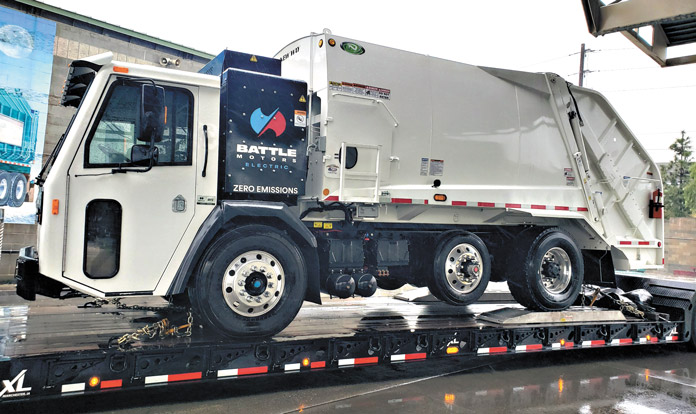 |
 Growing Into Success: What will success look like for the program?
Growing Into Success: What will success look like for the program?
Bill: Like Ron said, cleaner skies in the future, for starters.
Ron: That, yes, and having vehicles that are truly zero emission, that can perform the duties that we need for them to do, and not having a bunch of issues during that time. Natural gas didn’t come easy; in fact, it’s still much more expensive to keep the natural gas fleet going. But we’ve never really taken in the expense as a deterrent to having a cleaner fuel vehicle. I’m hoping that the pros in the maintenance shop will balance out the cons of the maintenance. We want to have clean air, but again, it’s taxpayers’ money that is ultimately going to pay for this, and we want to get the best bang for the buck. And provide clean air, which is the most important. That’s our goal.
Charlotte: Success would be having equipment that works – both the electric truck and the EV charging station. And then vehicles being electrified on schedule – we won’t be able to electrify everything altogether. Just electrifying it on schedule would be a success. Also having good safety and maintenance programs is very important. It’s not just being electrified on time, but also being kept well-maintained and safe for use by our operators and safe for the public as well.
Bill: And we haven’t talked about oil changes. Each truck takes 44 quarts of oil for the engine every six weeks. When you multiply those 44 quarts by 550 – the number of our current fleet of Automated Side Loaders, not to mention all the other vehicles, that’s a whole lot of oil. Over time, like any vehicle does, they start leaking on the ground. You have oil on the streets. Electric power really is a cleaner future for everybody.
‘“You don’t get paid for the hour; you get paid for the value you bring to the hour.” I really like to think I give a lot of value to the hours I get paid.’
— Bill Musselman
 The Value in the Hours
The Value in the Hours
What do you love about what you do?
Bill: That I’m able to do so many different things as far as new vehicles. Everybody has a different view of what they’re looking at; you could have 10 different people looking at one thing, and it’s 10 different opinions on what it is. I like to think that sometimes my input is much different than someone else’s. I might see something that no one else would see; that makes a difference, that really changes things. I love the variety of my tasks every day, not just as far as EVs go, but just my job in general. I love dealing with the public. I love making a difference in the city of LA, and I like to think that when I’m gone, I’ll be missed.
Beautiful. Of course you will be.
Charlotte: A lot of things actually. But I think the number one thing is I like working with the people I’m working with. It’s hard to be working on a goal when we are not on the same path, with the same goals. It helps that we are.
I like meeting a lot of new people, too, and making new friends. I’ve opened communication lines with people at the AQMD and made good relationships.
Also I like being a public servant, working for City residents and working for the people, knowing that I’m trying to save some taxpayer money for them. And since I’m a chemical engineer, doing some work related to technology. EV charging keeps me interested in what’s happening, including EV batteries. Those are very interesting to me. All of these complete me as an employee, as an Environmental Supervisor involved in environmental engineering.
Ron: What I like about my job the most is the people I work with. That really makes my day much easier, and makes me excited to come to work. And then like I said, when I was a kid, I saw the smog; I saw some of the issues we had with emissions and dirty air. To actually be a part of a solution, and provide cleaner air to the citizens of Los Angeles, really excites me day in and day out. Technically I could have been gone five years ago, but I’ve stuck around for five more years because I like the people I work with. We all go above and beyond what’s required of us.
This is definitely not a nine-to-five job. [I]t’s good to work with people like that, because it’s definitely not a nine to five job. We wouldn’t get very far if we limited ourselves to just the regular hours.
Bill: I recently saw something that said, “You don’t get paid for the hour, you get paid for the value you bring to the hour.” I really like to think I give a lot of value to the hours I get paid.
Ron and Bill and Charlotte, thank you so much for your time. This has been a very informative chat.
Bill: Thank you. I appreciate this.
Charlotte: Thank you.
Ron: Thank you. Have a good evening! •
| BEHIND THE SCENES
In front of City Hall, Club COO Summy Lam photographs the Sanitation team responsible for procuring, testing and maintaining the department’s growing fleet of electric vehicles.
|


